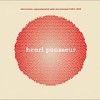 The fifth installment of Sub Rosa's series dedicated to the works of Henri Pousseur highlights the composer's efforts to experiment with different serialist techniques and tonal systems. The compositions presented on this disc span decades and feature a variety of musicians, including a rare performance from Pousseur himself.
The fifth installment of Sub Rosa's series dedicated to the works of Henri Pousseur highlights the composer's efforts to experiment with different serialist techniques and tonal systems. The compositions presented on this disc span decades and feature a variety of musicians, including a rare performance from Pousseur himself.
Admittedly, this can be a dry listen at times. Pousseur's experiments here reflect play with tonal systems that may be of more value to listeners with interest in academic music theory rather than those hoping for a more immediate visceral impact. Anyone hoping to hear electronic pieces resembling his blistering work "Scambi" may be disappointed to find that the only electronics found on this disc are live manipulations of a piece commissioned and performed by oboist Evert van Tright called "Ex Dei in Machinam Memora." Delayed and superimposed over Tright's oboe playing, the result is an enjoyable if sluggishly paced chamber piece.
No doubt, some of these pieces would be better appreciated in a live setting. "Prospection," Pousseur's "first and only rigorous serialist work" as he describes it in the liner notes, is a composition written for three pianos tuned one-sixth-tone apart. Heard blindly, the interaction between the performers is difficult to decipher without visual cues, and the piece loses a bit of its import in the process. A little more engaging is "Racine Dix-Neuvieme de Huit-Quarts" for solo cello in which Pousseur divides octaves into 19 parts, halfway between the 12-tone system and the 31-tone system Christian Huyghens developed in the 17th century. His 19-tone system creates atypical intervals and sounds unusual, if not exotic, and wholly unpredictable.
Pousseur's piece "At Moonlight, Dowland's Shadow Passes Along Ginkaku-Ji" was composed for a Japanese trio and performed at the Europalia festival in Brussels in 1989. Written for shamisen, koto, and shakuhachi, its 12-tone system in a Japanese mode was the composer's attempt to bring the two cultures together in a piece of music. Its glissandi and tremoli bring the piece to life marvelously and set it apart from the other tracks on this disc. Also unusual is the piece Pousseur performed himself, "Figures Enlacées," on an ancient organ that had recently been restored. Tuned to mesotonic temperament, the organ features three rows of major thirds laid out in just fifths. This piece contains both a purposeful harshness and an elegant purity, easily the disc's most dynamic track.
These works reflect Pousseur's restlessly inquisitive nature, one that challenges preconceptions about the construction and utilization of tonal systems and temperament. While important to the composer's development of both his own techniques and musical language itself, these compositions, for the most part, are more satisfying to the intellect than the ears.
samples:
Read More

